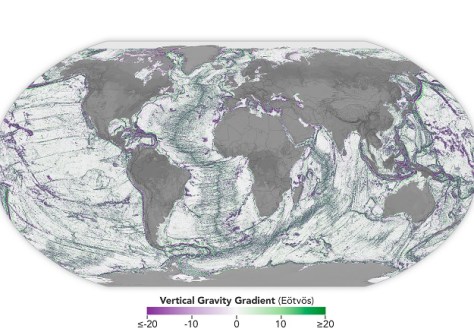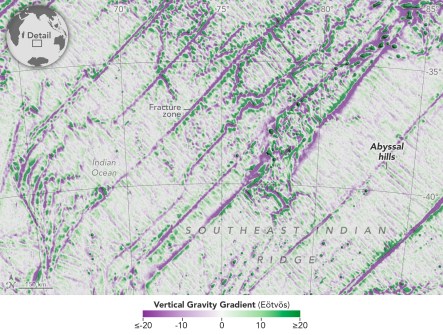
As part of an ongoing effort, a NASA-supported team recently published one of the most detailed maps yet of the ocean floor, using data from the SWOT (Surface Water and Ocean Topography) satellite.
SWOT is a collaboration between NASA and the French space agency CNES (Centre National d’Études Spatiales).
Although ships outfitted with sonar instruments can make direct measurements of the ocean floor, to date only about 25% of it has been surveyed in this way. To produce a global picture of the seafloor, researchers have relied on satellite data.
“Seafloor mapping is key in both established and emerging economic opportunities, including rare-mineral seabed mining, optimising shipping routes, hazard detection, and seabed warfare operations,” said Nadya Vinogradova Shiffer, head of physical oceanography programs at NASA Headquarters in Washington.
Accurate seafloor maps are also important for an improved understanding of deep-sea currents and tides, which affect life in the abyss, as well as geologic processes like plate tectonics.
Seamounts and other ocean floor features such as their smaller cousins, abyssal hills, influence the movement of heat and nutrients in the deep sea and can attract life.

The effects of these physical features can even be felt at the surface by the influence they exert on ecosystems that human communities depend on.
Mapping the seafloor isn’t the SWOT mission’s primary purpose. Launched in December 2022, the satellite measures the height of water on nearly all of Earth’s surface, including the ocean, lakes, reservoirs and rivers.
Researchers can use these differences in height to create a kind of topographic map of the surface of fresh- and seawater. This data can then be used for tasks such as assessing changes in sea ice or tracking how floods progress down a river.
“The SWOT satellite was a huge jump in our ability to map the seafloor,” said David Sandwell, a geophysicist at Scripps Institution of Oceanography in La Jolla, California. He’s used satellite data to chart the bottom of the ocean since the 1990s and was one of the researchers responsible for the SWOT-based seafloor map, which was published in the journal Science in December 2024.
The study authors relied on the fact that because geologic features like seamounts and abyssal hills have more mass than their surroundings, they exert a slightly stronger gravitational pull that creates small, measurable bumps in the sea surface above them.
These subtle gravity signatures help researchers predict the kind of seafloor feature that produced them.
Through repeated observations — SWOT covers about 90% of the globe every 21 days — the satellite is sensitive enough to pick up these minute differences, with centimetre-level accuracy, in sea surface height caused by the features below.
Sandwell and his colleagues used a year’s worth of SWOT data to focus on seamounts, abyssal hills and underwater continental margins, where continental crust meets oceanic crust.
Previous ocean-observing satellites have detected massive versions of these bottom features, such as seamounts over roughly 1 kilometre high.
The SWOT satellite can pick up seamounts less than half that height, potentially increasing the number of known seamounts from 44,000 to 100,000.

These underwater mountains stick up into the water, influencing deep sea currents. This can concentrate nutrients along their slopes, attracting organisms and creating oases on what would otherwise be barren patches of seafloor.
The improved view from SWOT also gives researchers more insight into the geologic history of the planet.
“Abyssal hills are the most abundant landform on Earth, covering about 70% of the ocean floor,” said Yao Yu, an oceanographer at Scripps Institution of Oceanography and lead author on the paper.
“These hills are only a few kilometres wide, which makes them hard to observe from space. We were surprised that SWOT could see them so well.”
Abyssal hills form in parallel bands, where tectonic plates spread apart. The orientation and extent of the bands can reveal how tectonic plates have moved over time. Abyssal hills also interact with tides and deep ocean currents in ways that researchers don’t fully understand yet.
The researchers have extracted nearly all the information on seafloor features they expected to find in the SWOT measurements. Now they’re focusing on refining their picture of the ocean floor by calculating the depth of the features they see.
The work complements an effort by the international scientific community to map the entire seafloor using ship-based sonar by 2030.
“We won’t get the full ship-based mapping done by then,” said Sandwell. “But SWOT will help us fill it in, getting us close to achieving the 2030 objective.”







